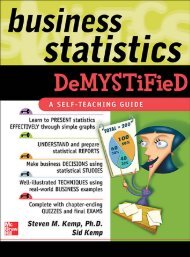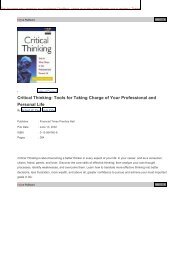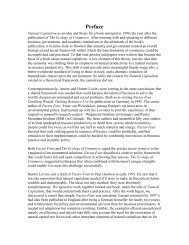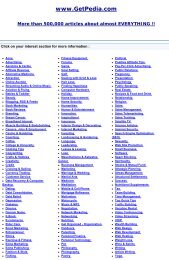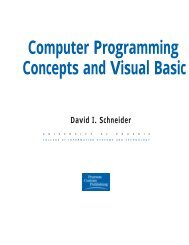Chapter 06 - Changing Education Paradigm
Chapter 06 - Changing Education Paradigm
Chapter 06 - Changing Education Paradigm
You also want an ePaper? Increase the reach of your titles
YUMPU automatically turns print PDFs into web optimized ePapers that Google loves.
4 CHAPTER 6. MINING ASSOCIATION RULES IN LARGE DATABASES<br />
Market analyst<br />
Hmmm, which items are frequently<br />
purchased together by my customers?<br />
milk cereal<br />
bread<br />
milk eggs<br />
bread<br />
sugar<br />
bread<br />
butter<br />
milk<br />
Customer 1<br />
Customer 2 Customer 3<br />
SHOPPING BASKETS<br />
Figure 6.1: Market basket analysis.<br />
...<br />
...<br />
sugar eggs<br />
Customer n<br />
items. In an alternative strategy, placing hardware and software at opposite ends of the store may entice customers<br />
who purchase such items to pick up other items along the way. For instance, after deciding on an expensive computer,<br />
a customer may observe security systems for sale while heading towards the software display to purchase nancial<br />
management software, and may decide to purchase a home security system as well. Market basket analysis can also<br />
help retailers to plan which items to put on sale at reduced prices. If customers tend to purchase computers and<br />
printers together, then having a sale on printers may encourage the sale of printers as well as computers.<br />
If we think of the universe as the set of items available at the store, then each item has a Boolean variable<br />
representing the presence or absence of that item. Each basket can then be represented by a Boolean vector of values<br />
assigned to these variable. The Boolean vectors can be analyzed for buying patterns which re ect items that are<br />
frequent associated or purchased together. These patterns can be represented in the form of association rules. For<br />
example, the information that customers who purchase computers also tend to buy nancial management software<br />
at the same time is represented in association Rule (6.1) below.<br />
computer ) nancial management software [support =2%; confidence = 60%] (6.1)<br />
Rule support and con dence are two measures of rule interestingness that were described earlier in Section 1.5.<br />
They respectively re ect the usefulness and certainty of discovered rules. A support of 2% for association Rule (6.1)<br />
means that 2% of all the transactions under analysis show that computer and nancial management software are<br />
purchased together. A con dence of 60% means that 60% of the customers who purchased a computer also bought the<br />
software. Typically, association rules are considered interesting if they satisfy both a minimum support threshold<br />
and a minimum con dence threshold. Such thresholds can be set by users or domain experts.<br />
6.1.2 Basic concepts<br />
Let I=fi1, i2, :::, img be a set of items. Let D, the task relevant data, be a set of database transactions where each<br />
transaction T is a set of items such that T I. Each transaction is associated with an identi er, called TID. Let A<br />
be a set of items. A transaction T is said to contain A if and only if A T .Anassociation rule is an implication<br />
of the form A ) B, where A I,B Iand A \ B = . The rule A ) B holds in the transaction set D with<br />
support s, where s is the percentage of transactions in D that contain A [ B. The rule A ) B has con dence c



